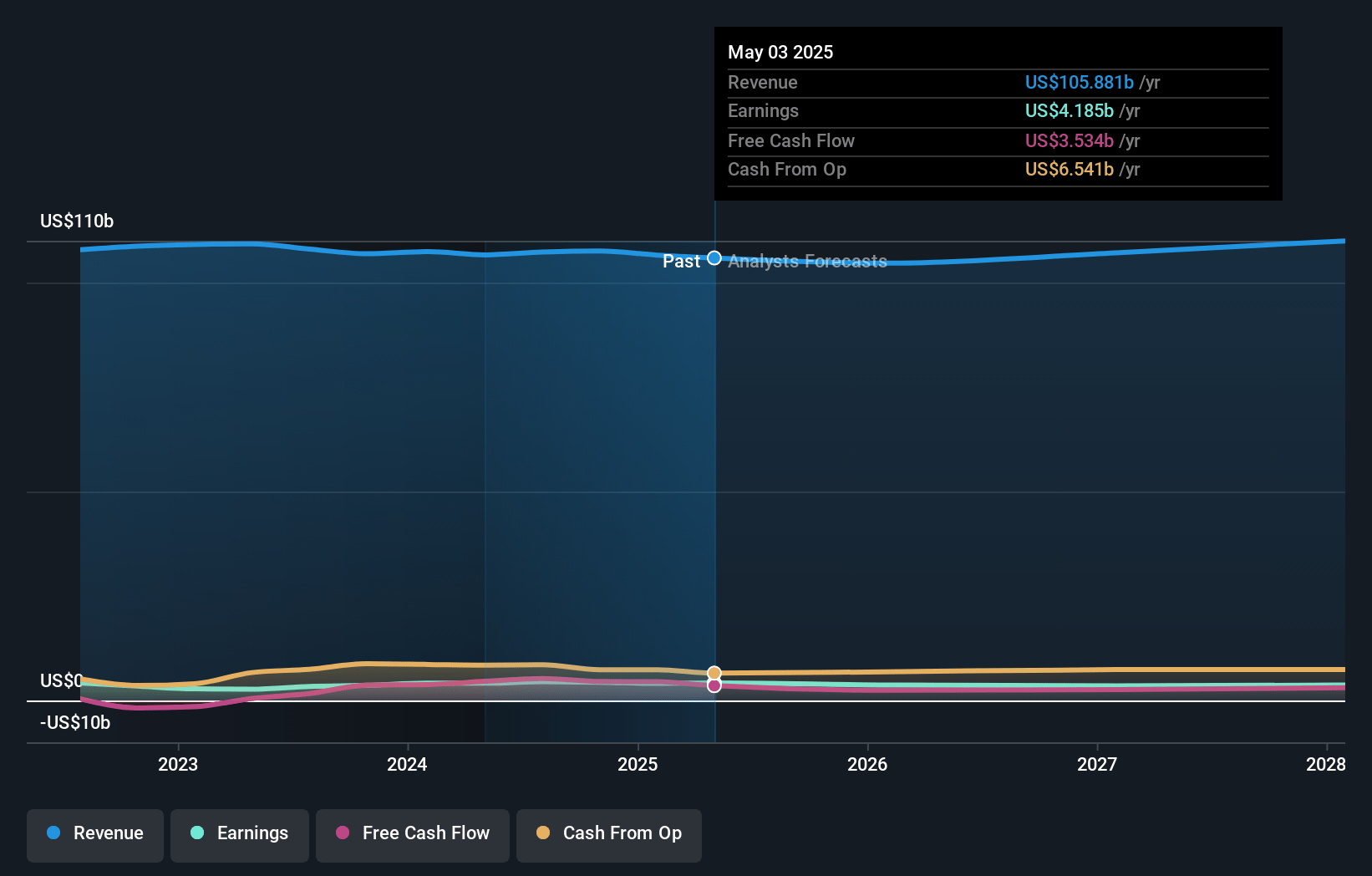Key Takeaways
- Strategic investments aim to enhance operational efficiency and boost revenue by modernizing stores, supply chain, and technology.
- Focus on loyalty programs and technology modernization drives market share gains, customer engagement, and improved profitability.
- Economic uncertainty, supply chain issues, and increased fulfillment costs could hinder Target's sales growth and profitability, impacting overall financial performance.
Catalysts
About Target- Operates as a general merchandise retailer in the United States.
- Target plans to invest $4 billion to $5 billion in stores, supply chain, and technology, aiming to drive revenue growth and improve operational efficiency over the next five years.
- Target intends to drive revenue growth by holding or increasing market share across most of its categories, with momentum observed in categories like Apparel and Beauty contributing positively to their top line.
- The expansion of Target Circle, their loyalty program, is a catalyst for increasing customer engagement and sales, aiming to grow earnings by extending personalized marketing and driving repeat purchases.
- Target's strategy to modernize core inventory management systems with AI could improve net margins by increasing in-stock reliability and reducing costs associated with inventory management.
- The growth of Target Plus as a $1 billion marketplace, positioning it for future revenue growth by diversifying its online product offerings, could significantly contribute to earnings in the upcoming years.
Target Future Earnings and Revenue Growth
Assumptions
How have these above catalysts been quantified?- This narrative explores a more pessimistic perspective on Target compared to the consensus, based on a Fair Value that aligns with the bearish cohort of analysts.
- The bearish analysts are assuming Target's revenue will decrease by 0.9% annually over the next 3 years.
- The bearish analysts assume that profit margins will shrink from 3.8% today to 3.0% in 3 years time.
- The bearish analysts expect earnings to reach $3.3 billion (and earnings per share of $7.62) by about April 2028, down from $4.1 billion today. The analysts are largely in agreement about this estimate.
- In order for the above numbers to justify the price target of the more bearish analyst cohort, the company would need to trade at a PE ratio of 18.2x on those 2028 earnings, up from 10.1x today. This future PE is lower than the current PE for the US Consumer Retailing industry at 24.0x.
- Analysts expect the number of shares outstanding to decline by 1.53% per year for the next 3 years.
- To value all of this in today's terms, we will use a discount rate of 6.99%, as per the Simply Wall St company report.
Target Future Earnings Per Share Growth
Risks
What could happen that would invalidate this narrative?- Economic uncertainty and consumer caution toward spending in discretionary categories could hinder Target's sales growth and negatively impact its revenue.
- Persistent challenges in maintaining high in-stock levels, particularly during peak shopping periods, could lead to missed sales opportunities and affect Target's profitability.
- The risk of increased tariffs could impact Target's cost of goods, which may squeeze net margins if the company cannot pass these costs on to consumers.
- The reliance on digital sales comes with higher fulfillment costs, which, despite growth, could dampen overall earnings if efficiency improvements do not keep pace.
- Volatility in apparel sales due to unpredictable weather and shifting trends may create inconsistency in revenue, impacting Target's overall financial performance.
Valuation
How have all the factors above been brought together to estimate a fair value?- The assumed bearish price target for Target is $111.95, which represents one standard deviation below the consensus price target of $129.94. This valuation is based on what can be assumed as the expectations of Target's future earnings growth, profit margins and other risk factors from analysts on the more bearish end of the spectrum.
- However, there is a degree of disagreement amongst analysts, with the most bullish reporting a price target of $160.0, and the most bearish reporting a price target of just $92.0.
- In order for you to agree with the bearish analysts, you'd need to believe that by 2028, revenues will be $109.6 billion, earnings will come to $3.3 billion, and it would be trading on a PE ratio of 18.2x, assuming you use a discount rate of 7.0%.
- Given the current share price of $90.46, the bearish analyst price target of $111.95 is 19.2% higher. Despite analysts expecting the underlying buisness to decline, they seem to believe it's more valuable than what the market thinks.
- We always encourage you to reach your own conclusions though. So sense check these analyst numbers against your own assumptions and expectations based on your understanding of the business and what you believe is probable.
How well do narratives help inform your perspective?
Disclaimer
AnalystLowTarget is an employee of Simply Wall St, but has written this narrative in their capacity as an individual investor. AnalystLowTarget holds no position in NYSE:TGT. Simply Wall St has no position in the company(s) mentioned. Simply Wall St may provide the securities issuer or related entities with website advertising services for a fee, on an arm's length basis. These relationships have no impact on the way we conduct our business, the content we host, or how our content is served to users. This narrative is general in nature and explores scenarios and estimates created by the author. The narrative does not reflect the opinions of Simply Wall St, and the views expressed are the opinion of the author alone, acting on their own behalf. These scenarios are not indicative of the company's future performance and are exploratory in the ideas they cover. The fair value estimate's are estimations only, and does not constitute a recommendation to buy or sell any stock, and they do not take account of your objectives, or your financial situation. Note that the author's analysis may not factor in the latest price-sensitive company announcements or qualitative material.
Read more narratives







